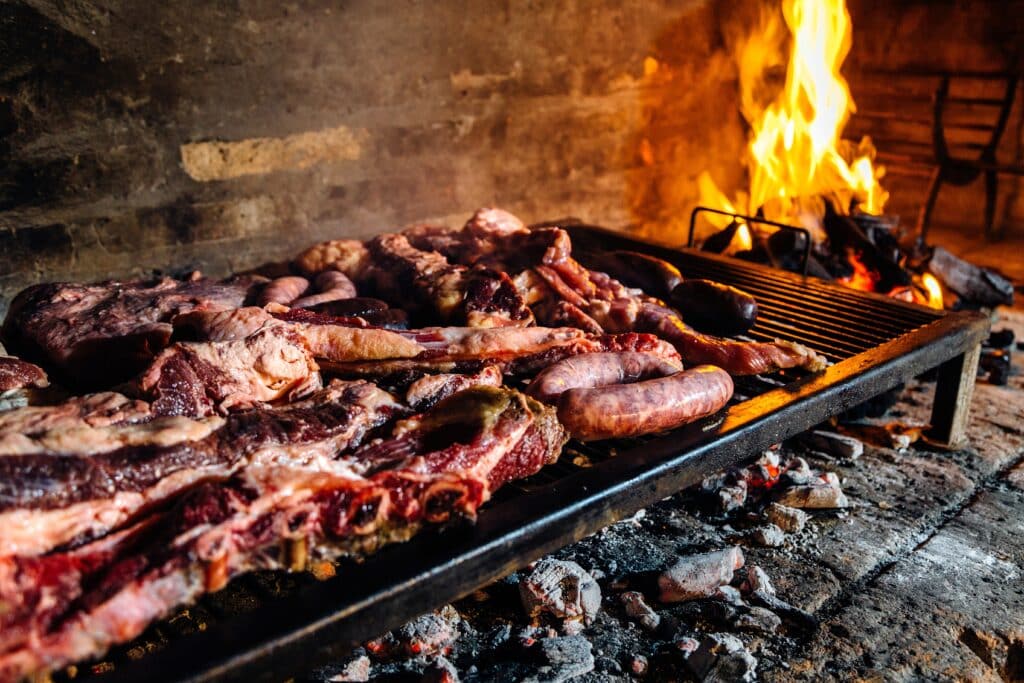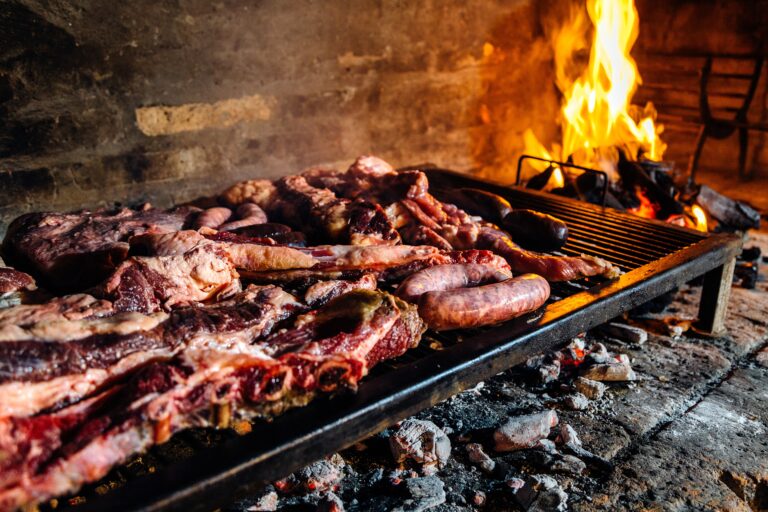 Asado is a cultural tradition in Uruguay that celebrates community, family, and the country’s rich heritage through the art of grilling high-quality beef over a wood fire.
Asado is a cultural tradition in Uruguay that celebrates community, family, and the country’s rich heritage through the art of grilling high-quality beef over a wood fire.
Asado refers to both the cooking technique and the social gathering centered around it. It holds a special place in the hearts of Uruguayans.
Our team at Remitly created this guide as part of our series that celebrates the traditional dishes of our global customers.
The Origins of Asado: A Cultural Tradition
Asado has been a part of Uruguayan culture for centuries, with its roots tracing back to the gauchos, the country’s iconic cowboys. The gauchos were skilled horsemen and cattle wranglers who roamed the vast plains of Uruguay and Argentina in the 18th and 19th centuries. As they travelled, they would grill meat over an open flame, using whatever materials were available to them.
This method of cooking meat over a wood fire became known as asado, and it gradually evolved into a symbol of Uruguayan identity. Today, the tradition is passed down through generations, with families and friends gathering together to celebrate special occasions and holidays with an asado feast.
The Art of Grilling: Uruguay’s Passion for Barbecue
Asado is more than just a way of cooking meat – it’s an art form that requires skill and patience. The process of preparing an asado involves selecting the right cuts of beef, seasoning them with salt and pepper, and then cooking them slowly over a wood fire. The grill master, or asador, carefully tends to the fire, adjusting the temperature and adding more wood as needed.
Uruguayans take their asado very seriously, and many families have their own secret recipes and techniques for grilling meat. It’s not uncommon to spend several hours cooking the meat, and the asador must be attentive to ensure that each piece is cooked to perfection.
Slow Cooking: Unraveling the Secrets of Asado
One of the secrets to Uruguay’s delicious asado is the slow cooking process. The meat is cooked over a low flame, sometimes for several hours, allowing it to become tender and juicy. This slow cooking also allows the flavors of the wood smoke to penetrate the meat, giving it a unique, smoky taste.
Another secret to great asado is the quality of the beef. Uruguay is known for its high-quality beef, which comes from grass-fed cattle that roam free on the country’s vast grasslands. The beef is lean and flavorful, with a distinct taste that is perfect for grilling over an open flame.
Asado: The Heart of Uruguayan Cuisine
Asado is more than just a way of cooking meat – it’s a symbol of Uruguayan culture and identity. It’s a celebration of community, family, and tradition. In Uruguay, asado is a social gathering that brings people together to share food, stories, and laughter.
Whether it’s a family gathering, a birthday celebration, or a national holiday, asado is at the heart of Uruguayan cuisine. It’s a tradition that is passed down from generation to generation, and it’s a source of pride for the people of Uruguay.
Wood Fire: The Essential Element of Asado
One of the key elements of asado is the use of wood fire. The wood adds flavor to the meat and gives it a unique smoky taste that can’t be replicated with other cooking methods. Many Uruguayan families have their own preferred types of wood for grilling, with some using eucalyptus, others preferring quebracho, and still others opting for a combination of different woods.
The wood fire also creates a special ambiance that is part of the asado experience. The aroma of the wood smoke fills the air, creating a warm and inviting atmosphere that is perfect for socializing and enjoying good food.
Beef: The Star Ingredient of Uruguay’s National Dish
At the heart of asado is high-quality beef, which is the star ingredient of Uruguay’s national dish. The country’s grass-fed cattle produce lean, flavorful meat that is perfect for grilling over a wood fire.
The most popular cuts of beef for asado include vacío (flank steak), asado de tira (short ribs), and entraña (skirt steak).
These meats are usually seasoned with a simple blend of salt and pepper, allowing the natural flavors to shine through.
Recipe: Traditional Uruguayan Asado
Ingredients:
- 2 kg (4.4 lbs) of high-quality beef cuts (such as vacío, asado de tira, and entraña)
- Salt, to taste
- Pepper, to taste
- Wood for grilling (eucalyptus, quebracho, or a combination)
Instructions:
- Prepare the wood fire: Start by arranging the wood in a pyramid shape in your grill or fire pit. Use newspaper or fire starters to ignite the wood, allowing it to burn until you have a bed of hot coals.
- Season the meat: While the fire is burning, season the beef cuts generously with salt and pepper on both sides. Allow the meat to sit at room temperature for about 30 minutes to absorb the flavors.
- Start grilling: Once the fire has burned down to hot coals, spread them evenly across the grill. Place the beef cuts directly over the coals, starting with the thicker cuts first.
- Control the heat: As the meat cooks, it’s important to control the heat by adjusting the distance between the coals and the grill. Raise the grill higher for slower cooking or lower it for more intense heat.
- Flip and rotate: After a few minutes, flip the meat to cook the other side. Rotate the cuts occasionally to ensure even cooking and prevent burning.
- Monitor the cooking time: The cooking time will vary depending on the thickness of the cuts and your desired level of doneness. For medium-rare, cook the meat for about 10-15 minutes per side. Adjust the cooking time according to your preference.
- Rest the meat: Once the meat is cooked to your liking, remove it from the grill and let it rest for a few minutes. This allows the juices to redistribute and the meat to become even more tender.
- Slice and serve: Slice the meat against the grain into thin strips. Serve it hot with traditional accompaniments such as chimichurri sauce, grilled vegetables, and crusty bread.
Enjoy your traditional Uruguayan asado with family and friends, savoring the flavors and celebrating the rich cultural heritage of Uruguay.
Learn More About Uruguayan Cuisine
Uruguayan cuisine is a reflection of the country’s diverse cultural influences and its abundant natural resources.
Meat: A Staple of Uruguayan Cuisine
Asado may be the most famous dish in Uruguay, but it’s not the only meat-based delicacy that the country has to offer. Uruguayan cuisine is known for its love of beef, and it’s not uncommon to find a wide variety of cuts and preparations on the menu. From succulent steaks to juicy burgers, meat lovers will find plenty to satisfy their cravings in Uruguay.
Empanadas: A Tasty Handheld Treat
Empanadas are a popular snack or appetizer in Uruguay. These savory pastries are typically filled with a variety of ingredients, such as beef, cheese, ham, or vegetables. The dough is folded over the filling and then baked or fried to perfection. Empanadas are often enjoyed as a quick bite on the go or as part of a larger meal.
Chivito: A Hearty Sandwich
The chivito is a classic Uruguayan sandwich that is sure to satisfy even the heartiest appetite. It typically consists of a tender beef steak, topped with ham, cheese, lettuce, tomato, and mayonnaise. Some variations may also include bacon, olives, or fried eggs.
Dulce de Leche: A Sweet Delight
No exploration of Uruguayan cuisine would be complete without mentioning dulce de leche. This creamy caramel sauce is made by slowly cooking sweetened condensed milk until it thickens and develops a rich, caramel flavor. Dulce de leche is used in a variety of desserts, such as alfajores (shortbread cookies filled with dulce de leche) and churros (fried dough pastries dipped in dulce de leche).
Uruguayan cuisine is a celebration of flavors, traditions, and the country’s rich cultural heritage. From the smoky flavors of asado to the sweet indulgence of dulce de leche, there’s something to delight every palate. So, whether you’re visiting Uruguay or simply want to explore its culinary delights, be sure to savor the unique flavors of Uruguayan cuisine.
Visit the homepage, download our app, or check out our Help Center to get started.
